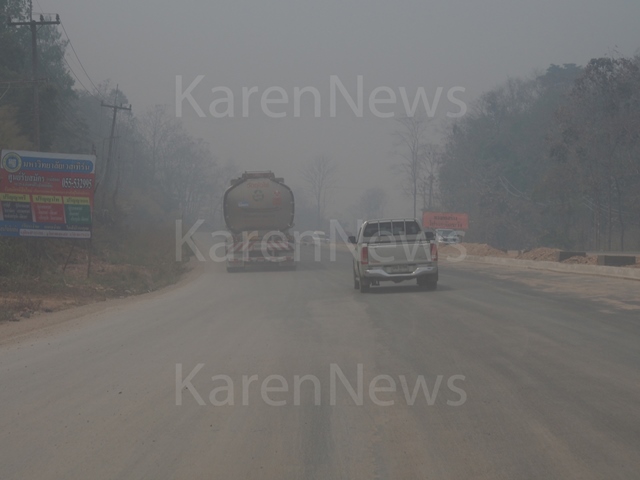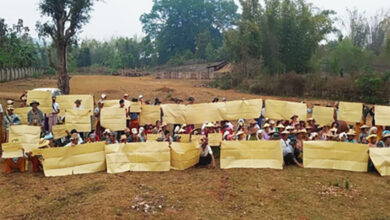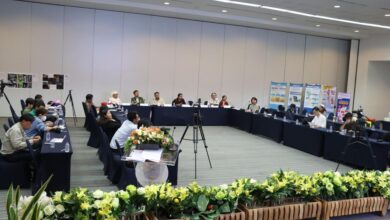Mae Sot: Border Pollution ‘Worst Yet’

Thick haze has blanketed the Thai-Burma border district of Mae Sot with local residents claiming it is the worst in living memory. Thick smoke made highways dangerous, caused airline flights in and out of Mae Sot to be cancelled forcing visitors into taking lengthy bus trips.
Dense smoke swallowed heavily laden timber trucks as they drove down the Asia Highway towards the Burma border.
Residents in Mae Sot, a trading town linking Thailand to Burma, said they have now had five months of smoke filled days. Residents said this year is worse than any other year as it is not just farmer’s burning crop stubble after harvest in April. Residents point out that the haze started at the beginning of November and is much heavier and denser than in previous years. Residents said that fires in forests in and around Mae Sot are being lit at night leaving the days without blue sky.
Khun Gade, 28, a pharmacist in Mae Sot, said that this year was the worst she had seen since moving from Chiang Mai five years ago.
“This year seems worse than last year and it started earlier. Normally if it gets hazy, it might happen around April or May, but not March.”
She noted that people were coming to seek medication for sore eyes and respiratory related illnesses.
“People are coming in with irritated eyes. Last week I had irritated eyes too. Airplanes have been cancelled. Normally this haze happens in Mae Hong Son, or Chiang Mai, but not so much up here in Mae Sot.”
A customer enters the pharmacy with a cough, Gade and the customer exchange words in Thai before she sells him some cough medicine – she later explains that he told her he had opened up his window last night before going to sleep and breathed in too much bad air.
Gade said that many people had been purchasing facemasks for the smog since last week. “We have seen a lot of people coming in to the pharmacy to buy masks.”
Khun Aet, a Thai and English language teacher and a native of Mae Sot, said that the air pollution was getting worse. “Everyone is affected. Sometimes we have to close the door because it is difficult to breathe. It affects my eyes as well,” he said.
“It is bad, very bad. I can hardly see the mountains, and at night I see fires in the countryside.” Katina, 24, an aid worker from Germany now living in the Mae Sot said.
“People are covering their mouths and noses on the bus. I don’t think there is much awareness about the environment here generally,” Katina added.
Khun Ni Pa, a mother from Mae Sot, said her daughter had to be hospitalised last week with breathing problems because the air was so bad this year.
“This bad haze only started happening in the last three years. It is because of farming, particularly sugar cane, and factories. Now it is really bad… my daughter even had to go to the hospital because she was having difficulty breathing.”
Ni Pa said that the haze affected her health.
“It hurts my nose, eyes and sinuses. I have had a bad headache for the last two days because of this air.”
Ni Pa also said that many of her friends and neigbours had experienced similar symptoms, “Most of the people I know are experiencing the same things because of the air.”
A 2011 academic article in the Environmental Health Perspectives journal noted:
“In the rural and border areas, most notably Chiangmai, agricultural burning and forest fires, including transboundary haze from Myanmar [Burma], have contributed to high levels of PM10, which have increased to critical levels since 2006 – 250 μg/m3, 300 μg/m3, 175 μg/m3, and 220 μg/m3 in 2006, 2007, 2008, and 2009, respectively. More importantly, many consecutive days of high PM10 levels resulted in increases in hospital admissions and outpatient visits.”
PM10 pollutants are pieces of matter that are less than 10μm in aerodynamic diameter. The report warned that PM10 was associated with “premature mortality and a wide range of morbidity outcomes.”
“In cities such as Bangkok, air quality monitoring performed by the Pollution Control Department (PCD) for the past 10 years revealed that the levels of PM10 have exceeded both annual (50 μg/m3) and 24-hr (120 μg/m3) national standards,” the report added.
Lucy, an English teacher and a frequent holiday visitor to Thailand, said the smoke pollution was the worst she had ever seen.
“All of my students have symptoms like they have a cold because of the air pollution. One of my students who has asthma, has difficulty breathing in class – especially in the morning.”
Khun Aum, a high school student, said that this was the first year she had eye problems with the air.
“The smoke is bad enough now to hurt my eyes. A lot of my friends are wearing facemasks.”




